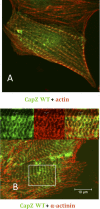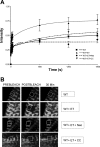CapZ dynamics are altered by endothelin-1 and phenylephrine via PIP2- and PKC-dependent mechanisms
- PMID: 19295171
- PMCID: PMC2681383
- DOI: 10.1152/ajpcell.00544.2008
CapZ dynamics are altered by endothelin-1 and phenylephrine via PIP2- and PKC-dependent mechanisms
Abstract
One of the unanswered questions in muscle hypertrophy is how new contractile units are inserted into a stable existing cytoskeletal meshwork. Regulation of actin capping by CapZ may play a role in remodeling processes, therefore, CapZ dynamics are determined during rapid growth of cardiac cells in vitro. Neonatal rat ventricular myocytes were infected with adenovirus expressing green fluorescent protein-CapZ beta1 and responded normally to hypertrophic stimuli. CapZ dynamics were analyzed by fluorescence recovery after photobleaching in cultured myocytes treated with endothelin-1 (100 nM) or phenylephrine (10 muM). Recovery by 30 s was greater with endothelin treatment. Analysis 30 min postbleach showed CapZ-infected cells treated with endothelin recovered more completely than controls (77 +/- 9% vs. 50 +/- 6%, P < 0.001). Similar results were found with phenylephrine (77 +/- 5%, P < 0.05). A potential mechanism for phosphatidylinositol bisphosphate (PIP2) mediation of increased CapZ exchange in endothelin- and phenylephrine-treated cells was tested. PIP2 sequestration with neomycin (500 muM) blocked both endothelin- (43 +/- 6%, P < 0.001) and phenylephrine (36 +/- 4%, P < 0.001)-mediated recovery. The protein kinase C inhibitor chelerythrine chloride (10 muM) also blocked endothelin- (53 +/- 10%, P < 0.001) and phenylephrine (42 +/- 3%, P < 0.001)-mediated recovery. This study demonstrates for the first time that endothelin and phenylephrine alter CapZ dynamics through PIP2- and PKC-dependent pathways, which might destabilize the existing framework and permit sarcomeric remodelling to proceed.
Figures



Similar articles
-
Myofibril growth during cardiac hypertrophy is regulated through dual phosphorylation and acetylation of the actin capping protein CapZ.Cell Signal. 2016 Aug;28(8):1015-24. doi: 10.1016/j.cellsig.2016.05.011. Epub 2016 May 13. Cell Signal. 2016. PMID: 27185186 Free PMC article.
-
CapZ and actin capping dynamics increase in myocytes after a bout of exercise and abates in hours after stimulation ends.J Appl Physiol (1985). 2013 Jun;114(11):1603-9. doi: 10.1152/japplphysiol.01283.2012. Epub 2013 Mar 14. J Appl Physiol (1985). 2013. PMID: 23493359 Free PMC article.
-
Phosphatidylinositol 4,5-bisphosphate regulates CapZβ1 and actin dynamics in response to mechanical strain.Am J Physiol Heart Circ Physiol. 2013 Dec 1;305(11):H1614-23. doi: 10.1152/ajpheart.00477.2013. Epub 2013 Sep 16. Am J Physiol Heart Circ Physiol. 2013. PMID: 24043251 Free PMC article.
-
CapZ integrates several signaling pathways in response to mechanical stiffness.J Gen Physiol. 2019 May 6;151(5):660-669. doi: 10.1085/jgp.201812199. Epub 2019 Feb 26. J Gen Physiol. 2019. PMID: 30808692 Free PMC article.
-
PRKCE gene encoding protein kinase C-epsilon-Dual roles at sarcomeres and mitochondria in cardiomyocytes.Gene. 2016 Sep 15;590(1):90-6. doi: 10.1016/j.gene.2016.06.016. Epub 2016 Jun 13. Gene. 2016. PMID: 27312950 Free PMC article. Review.
Cited by
-
Integration of troponin I phosphorylation with cardiac regulatory networks.Circ Res. 2013 Jan 18;112(2):355-66. doi: 10.1161/CIRCRESAHA.112.268672. Circ Res. 2013. PMID: 23329791 Free PMC article. Review.
-
Myofibril growth during cardiac hypertrophy is regulated through dual phosphorylation and acetylation of the actin capping protein CapZ.Cell Signal. 2016 Aug;28(8):1015-24. doi: 10.1016/j.cellsig.2016.05.011. Epub 2016 May 13. Cell Signal. 2016. PMID: 27185186 Free PMC article.
-
Phorbol ester and endothelin-1 alter functional expression of Na+/Ca2+ exchange, K+, and Ca2+ currents in cultured neonatal rat myocytes.Am J Physiol Heart Circ Physiol. 2011 Feb;300(2):H617-26. doi: 10.1152/ajpheart.00388.2010. Epub 2010 Dec 3. Am J Physiol Heart Circ Physiol. 2011. PMID: 21131481 Free PMC article.
-
PI(4,5)P2: signaling the plasma membrane.Biochem J. 2022 Nov 11;479(21):2311-2325. doi: 10.1042/BCJ20220445. Biochem J. 2022. PMID: 36367756 Free PMC article.
-
CapZ and actin capping dynamics increase in myocytes after a bout of exercise and abates in hours after stimulation ends.J Appl Physiol (1985). 2013 Jun;114(11):1603-9. doi: 10.1152/japplphysiol.01283.2012. Epub 2013 Mar 14. J Appl Physiol (1985). 2013. PMID: 23493359 Free PMC article.
References
-
- Anderson KE, Dart AM, Woodcock EA. Inositol phosphate release and metabolism during myocardial ischemia and reperfusion in rat heart. Circ Res 76 261–268, 1995. - PubMed
-
- Boateng SY, Hartman TJ, Ahluwalia N, Vidula H, Desai TA, Russell B. Inhibition of fibroblast proliferation in cardiac myocyte cultures by surface microtopography. Am J Physiol Cell Physiol 285: C171–C182, 2003. - PubMed
-
- Chmura SJ, Dolan ME, Cha A, Mauceri HJ, Kufe DW, Weichselbaum RR. In vitro and in vivo activity of protein kinase C inhibitor chelerythrine chloride induces tumor cell toxicity and growth delay in vivo. Clin Can Res 6: 737–742, 2000. - PubMed
-
- Clerk A, Bogoyevitch MA, Andersson MB, Sugden PH. Differential activation of protein kinase C isoforms by endothelin-1 and phenylephrine and subsequent stimulation of p42 and p44 mitogen-activated protein kinases in ventricular myocytes cultured from neonatal rat hearts. J Biol Chem 269: 32845–32857, 1994. - PubMed
Publication types
MeSH terms
Substances
Grants and funding
LinkOut - more resources
Full Text Sources

